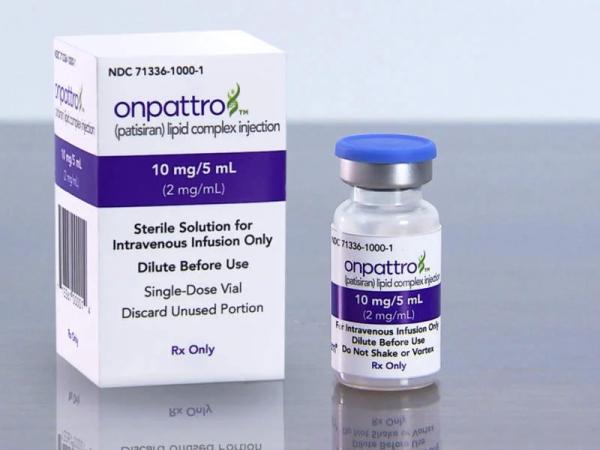Patisiran Dosage
Medically reviewed by Drugs.com. Last updated on Nov 4, 2024.
Applies to the following strengths: 2 mg/mL
Usual Adult Dose for:
Additional dosage information:
Usual Adult Dose for Amyloidogenic Transthyretin Amyloidosis
Recommended dose based on actual body weight:
- Weight less than 100 kg: 0.3 mg/kg intravenously once every 3 weeks
- Weight 100 kg or greater: 30 mg intravenously once every 3 weeks
Infuse at an initial rate of approximately 1 mL/min for the first 15 minutes, then increase to approximately 3 mL/min over 80 minutes.
PREMEDICATION: Administer on the day of infusion at least 60 minutes prior to the start of infusion:
- Oral acetaminophen 500 mg
- Intravenous Corticosteroid (e.g., dexamethasone 10 mg or equivalent)
- Intravenous H1 blocker (e.g., diphenhydramine 50 mg or equivalent)
- Intravenous H2 blocker (e.g., ranitidine 50 mg or equivalent)
Comments:
- The duration of infusion may be extended in the event of an infusion-related reaction (IRR).
- If intravenous premedications are not available or not tolerated, oral equivalents may be used.
- If patients are tolerating the infusion, but experiencing adverse reactions to corticosteroid premedication, reduce corticosteroid in 2.5 mg increments to a minimum dexamethasone 5 mg intravenous dose or equivalent.
- Some patients may require additional or higher doses of one or more premedications to reduce the risk of IRRs.
Use: For the treatment of adults with polyneuropathy of hereditary transthyretin-mediated amyloidosis.
Renal Dose Adjustments
- Mild or moderate renal impairment (eGFR 30 to less than 90 mL/min/1.73 m [2]): No adjustment recommended
- Severe renal impairment or end-stage renal disease: Data not available
Liver Dose Adjustments
- Mild Liver Dysfunction (bilirubin 1 or less times the upper limit of normal [1 x ULN] and AST greater than 1 x ULN; OR bilirubin greater than 1 to 1.5 x ULN): No adjustment recommended
- Moderate or severe Liver Dysfunction: Data not available
Precautions
CONTRAINDICATIONS: None
Safety and efficacy have not been established in patients younger than 18 years.
Consult WARNINGS section for additional precautions.
Dialysis
Data not available
Other Comments
Administration advice:
- For intravenous use only.
- All patients should receive premedication to reduce the risk of infusion-related reactions (IRRs).
- If a dose is missed, it should be administered as soon as possible. If administration is within 3 days of the missed dose, dosing may be resumed on the original schedule. If administered more than 3 days after the missed dose, continue dosing every 3 weeks, thereafter.
- See manufacturer product information for detailed infusion instructions.
Storage requirements:
- Store vials in refrigerator at 36F to 46F (2C to 8C). Do not freeze. Discard if frozen.
- May store at room temperature up to 77F (25C) for up to 14 days.
Reconstitution/preparation techniques:
- The manufacturer's product information should be consulted for detailed instructions.
Monitoring:
- Metabolic: Vitamin A deficiency
General:
- Physicians are encouraged to enroll pregnant patients or pregnant women may register by calling 1-877-256-9526 or via email at alnylampregnancyprogroam@iqvia.com.
Patient advice:
- Infusion-related reactions may occur during therapy. Contact your healthcare provider as soon as signs and symptoms occur.
- This medication potentially decreases vitamin A levels. The healthcare personnel will provide specific information about vitamin A supplementation. Notify your healthcare professional of any sight problem you experience.
- Female patients of childbearing potential who are pregnant or planning to become pregnant should first consult your healthcare provider.
Frequently asked questions
- Onpattro vs Tegsedi - how do they compare?
- How does Onpattro (patisiran) work?
- What type of drug is Onpattro?
More about patisiran
- Compare alternatives
- Side effects
- During pregnancy
- Drug class: miscellaneous metabolic agents
- En español
Patient resources
Other brands
Professional resources
Other brands
Related treatment guides
See also:
Further information
Always consult your healthcare provider to ensure the information displayed on this page applies to your personal circumstances.


